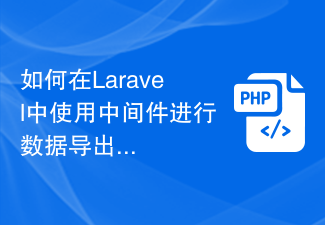This article mainly introduces the use of laravel middleware, which has certain reference value. Now I share it with everyone. Friends in need can refer to it
Usage of laravel middleware:
Create middleware command
php artisan make:middleware CheckLogin
After executing the above command, a new middleware class CheckLogin.php will be created in the app/Http/Middleware directory.
After creation, you still need to register the middleware in app/Http/Kernel.php:
protected $routeMiddleware = [
'auth' => \Illuminate\Auth\Middleware\Authenticate::class,
'auth.basic' => \Illuminate\Auth\Middleware\AuthenticateWithBasicAuth::class,
'bindings' => \Illuminate\Routing\Middleware\SubstituteBindings::class,
'can' => \Illuminate\Auth\Middleware\Authorize::class,
'guest' => \App\Http\Middleware\RedirectIfAuthenticated::class,
'throttle' => \Illuminate\Routing\Middleware\ThrottleRequests::class,
//这就是新注册的中间件
'checklogin' => \App\Http\Middleware\CheckLogin::class, ];You can write verification in the newly created middleware as follows:
<?php
namespace App\Http\Middleware;
use Closure;
use Illuminate\Support\Facades\Session;
class CheckLogin{
/**
* Handle an incoming request.
*
* @param \Illuminate\Http\Request $request
* @param \Closure $next
* @return mixed
*/
public function handle($request, Closure $next)
{
$userid = Session::get('_userid');
$login_sts = Session::get('_login_sts');
if (empty($userid) || empty($login_sts)){
return response()->view('admin/login');
}
return $next($request);
}
}The next step is how to use the middleware function
Route::group(['namespace'=>'Admin','middleware'=>'checklogin'],function (){
Route::get('admins','IndexController@index');
Route::get('logout','IndexController@logout');});The routing group is used directly here. As long as the routing is placed in the group, it will go through this verification. ['namespace'=>'Admin'] is Namespace, ['middleware'=>'checklogin'] This is middleware verification. The registration name was checklogin when registering before, so just write checklogin directly after middleware.
The above is the entire content of this article. I hope it will be helpful to everyone's study. For more related content, please pay attention to the PHP Chinese website!
Related recommendations:
Laravel Modify the default log file name and location
Use laravel dingo api plug-in library to create api method
The above is the detailed content of Use of laravel middleware. For more information, please follow other related articles on the PHP Chinese website!
 如何在Laravel中使用中间件处理异常Nov 04, 2023 pm 02:26 PM
如何在Laravel中使用中间件处理异常Nov 04, 2023 pm 02:26 PM如何在Laravel中使用中间件处理异常中间件是Laravel框架中的一个重要概念,它可以在请求到达控制器之前和之后进行一系列的操作。除了常见的权限验证、日志记录等功能,中间件还可以被用来处理异常。在本文中,我们将探讨在Laravel中如何使用中间件处理异常,并提供具体的代码示例。首先,我们需要创建一个异常处理中间件。可以通过运行以下命令来生成一个中间件类:
 如何在Laravel中使用中间件进行数据导出Nov 02, 2023 am 08:29 AM
如何在Laravel中使用中间件进行数据导出Nov 02, 2023 am 08:29 AMLaravel是一个流行的PHPWeb应用程序框架,它提供了许多方便的功能来开发高性能、可扩展和易于维护的Web应用程序。其中一个重要的特性是中间件(Middleware),它可以在请求和响应之间执行某些操作。在本文中,我们将讨论如何使用中间件将数据导出为Excel文件。创建Laravel应用程序首先,我们需要创建一个Laravel应用程序。你可以使用co
 laravel中间件用来做什么Apr 09, 2024 pm 05:03 PM
laravel中间件用来做什么Apr 09, 2024 pm 05:03 PMLaravel 中间件被用于:1. 认证和授权;2. 处理 HTTP 请求和响应;3. 过滤响应;4. 记录和监控;5. 自定义应用程序行为。通过中间件,开发人员可以在路由控制器之外轻松地为应用程序添加功能和限制。
 Laravel中间件:为应用程序添加数据库迁移和版本管理Aug 02, 2023 am 10:17 AM
Laravel中间件:为应用程序添加数据库迁移和版本管理Aug 02, 2023 am 10:17 AMLaravel中间件:为应用程序添加数据库迁移和版本管理在开发和维护一个Web应用程序时,数据库迁移和版本管理是一个非常重要的任务。它们使我们能够轻松地管理数据库的结构和数据,而无需手动更新或重建数据库。Laravel框架提供了强大而便捷的数据库迁移和版本管理功能,通过使用中间件,我们可以更方便地集成这些功能到我们的应用程序中。首先,我们需要确保我们的Lar
 如何在Laravel中使用中间件进行微信登录授权Nov 03, 2023 am 10:55 AM
如何在Laravel中使用中间件进行微信登录授权Nov 03, 2023 am 10:55 AM如何在Laravel中使用中间件进行微信登录授权随着移动互联网的快速发展,第三方登录成为了用户快捷注册和登录的一种流行方式。其中,微信登录是最受欢迎的之一。对于开发者来说,如何在自己的网站或应用中使用微信登录进行授权是一个常见的需求。本文将介绍如何在Laravel框架中使用中间件来实现微信登录授权功能,并提供具体的代码示例。首先,我们需要下载并安装Larav
 laravel中间件是什么意思Apr 09, 2024 pm 05:15 PM
laravel中间件是什么意思Apr 09, 2024 pm 05:15 PMLaravel 中间件是 HTTP 请求和响应处理中的拦截器组件,用于通过自定义逻辑扩展应用程序功能。中间件会验证请求、修改数据、执行应用程序操作、重定向请求、处理错误和异常。Laravel 提供内置中间件,如 Auth 和 Throttle,也可创建自定义中间件。可通过全局中间件或路由中间件使用中间件,从而增强应用程序的安全性、功能性和可维护性。
 Laravel中间件:优化数据库查询和连接管理Jul 28, 2023 pm 07:40 PM
Laravel中间件:优化数据库查询和连接管理Jul 28, 2023 pm 07:40 PMLaravel中间件:优化数据库查询和连接管理概述:Laravel是一款功能强大的PHP框架,其中的中间件是其核心特性之一,用于处理请求和响应。在本文中,我们将重点讨论如何使用Laravel中间件优化数据库查询和连接管理,以提高应用程序的性能和扩展性。什么是中间件?在Laravel中,中间件是处理HTTP请求的过滤器。它们可以在请求到达应用程序之前或之后执行
 laravel中间件有哪些Apr 09, 2024 pm 03:33 PM
laravel中间件有哪些Apr 09, 2024 pm 03:33 PMLaravel 中间件分为五种类型:全局、路由、组、终止和自定。全局中间件适用于所有请求,路由中间件仅适用于特定路由,组中间件应用于一组路由,终止中间件在所有其他中间件和处理程序执行后执行,自定中间件由开发者创建并扩展 BaseMiddleware 类。


Hot AI Tools

Undresser.AI Undress
AI-powered app for creating realistic nude photos

AI Clothes Remover
Online AI tool for removing clothes from photos.

Undress AI Tool
Undress images for free

Clothoff.io
AI clothes remover

AI Hentai Generator
Generate AI Hentai for free.

Hot Article

Hot Tools

MinGW - Minimalist GNU for Windows
This project is in the process of being migrated to osdn.net/projects/mingw, you can continue to follow us there. MinGW: A native Windows port of the GNU Compiler Collection (GCC), freely distributable import libraries and header files for building native Windows applications; includes extensions to the MSVC runtime to support C99 functionality. All MinGW software can run on 64-bit Windows platforms.

DVWA
Damn Vulnerable Web App (DVWA) is a PHP/MySQL web application that is very vulnerable. Its main goals are to be an aid for security professionals to test their skills and tools in a legal environment, to help web developers better understand the process of securing web applications, and to help teachers/students teach/learn in a classroom environment Web application security. The goal of DVWA is to practice some of the most common web vulnerabilities through a simple and straightforward interface, with varying degrees of difficulty. Please note that this software

SecLists
SecLists is the ultimate security tester's companion. It is a collection of various types of lists that are frequently used during security assessments, all in one place. SecLists helps make security testing more efficient and productive by conveniently providing all the lists a security tester might need. List types include usernames, passwords, URLs, fuzzing payloads, sensitive data patterns, web shells, and more. The tester can simply pull this repository onto a new test machine and he will have access to every type of list he needs.

WebStorm Mac version
Useful JavaScript development tools

SublimeText3 Linux new version
SublimeText3 Linux latest version







